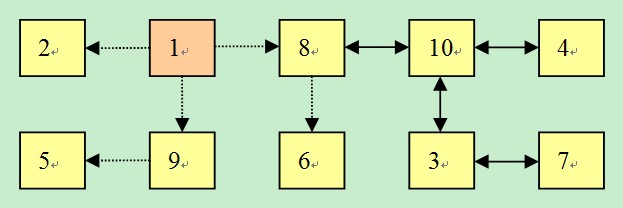еҗқ啬зҡ„еӣҪеәҰ
ж—¶й—ҙйҷҗеҲ¶пјҡ1000ms | еҶ…еӯҳйҷҗеҲ¶пјҡ65535KB
йҡҫеәҰпјҡ3
жҸҸиҝ°
еңЁдёҖдёӘеҗқ啬зҡ„еӣҪеәҰйҮҢжңүNдёӘеҹҺеёӮпјҢиҝҷNдёӘеҹҺеёӮй—ҙеҸӘжңүN-1жқЎи·ҜжҠҠиҝҷдёӘNдёӘеҹҺеёӮиҝһжҺҘиө·жқҘгҖӮзҺ°еңЁпјҢTomеңЁз¬¬SеҸ·еҹҺеёӮпјҢд»–жңүеј иҜҘеӣҪең°еӣҫпјҢд»–жғізҹҘйҒ“еҰӮжһңиҮӘе·ұиҰҒеҺ»еҸӮи§Ӯ第TеҸ·еҹҺеёӮпјҢеҝ…йЎ»з»ҸиҝҮзҡ„еүҚдёҖдёӘеҹҺеёӮжҳҜеҮ еҸ·еҹҺеёӮпјҲеҒҮи®ҫдҪ дёҚиө°йҮҚеӨҚзҡ„и·ҜпјүгҖӮ
иҫ“е…Ҙ
第дёҖиЎҢиҫ“е…ҘдёҖдёӘж•ҙж•°MиЎЁзӨәжөӢиҜ•ж•°жҚ®е…ұжңүM(1<=M<=5)з»„
жҜҸз»„жөӢиҜ•ж•°жҚ®зҡ„第дёҖиЎҢиҫ“е…ҘдёҖдёӘжӯЈж•ҙж•°N(1<=N<=100000)е’ҢдёҖдёӘжӯЈж•ҙж•°S(1<=S<=100000)пјҢNиЎЁзӨәеҹҺеёӮзҡ„жҖ»дёӘж•°пјҢSиЎЁзӨәеҸӮи§ӮиҖ…жүҖеңЁеҹҺеёӮзҡ„зј–еҸ·
йҡҸеҗҺзҡ„N-1иЎҢпјҢжҜҸиЎҢжңүдёӨдёӘжӯЈж•ҙж•°a,b(1<=a,b<=N)пјҢиЎЁзӨә第aеҸ·еҹҺеёӮе’Ң第bеҸ·еҹҺеёӮд№Ӣй—ҙжңүдёҖжқЎи·ҜиҝһйҖҡгҖӮ
иҫ“еҮә
жҜҸз»„жөӢиҜ•ж•°жҚ®иҫ“NдёӘжӯЈж•ҙж•°пјҢе…¶дёӯпјҢ第iдёӘж•°иЎЁзӨәд»ҺSиө°еҲ°iеҸ·еҹҺеёӮпјҢеҝ…йЎ»иҰҒз»ҸиҝҮзҡ„дёҠдёҖдёӘеҹҺеёӮзҡ„зј–еҸ·гҖӮпјҲе…¶дёӯi=Sж—¶пјҢиҜ·иҫ“еҮә-1пјү
ж ·дҫӢиҫ“е…Ҙ
1
10 1
1 9
1 8
8 10
10 3
8 6
1 2
10 4
9 5
3 7
ж ·дҫӢиҫ“еҮә
-1 1 10 10 9 8 3 1 1 8
еҫҲжҳҺжҳҫпјҢиҝҷдёӘдәӣеҹҺеёӮе’ҢйҒ“и·Ҝжһ„жҲҗдәҶдёҖдёӘжһҒе°ҸиҝһйҖҡеӯҗеӣҫпјҢд№ҹе°ұжҳҜз”ҹжҲҗж ‘гҖӮиҖҢеҮәеҸ‘зҡ„еҹҺеёӮSе°ұзӣёеҪ“дәҺиҝҷжЈөж ‘зҡ„ж ‘ж №пјҢдёҖз§Қиҫғжҳ“жғіеҲ°зҡ„и§Јжі•е°ұжҳҜд»ҺеҮәеҸ‘еҹҺеёӮејҖе§ӢпјҢеҜ№ж•ҙдёӘең°еӣҫиҝӣиЎҢж·ұеәҰжҗңзҙўпјҢиҝҮзЁӢдёӯи®°еҪ•дёӢеүҚдёҖдёӘеҹҺеёӮзҡ„зј–еҸ·пјҢеҰӮдёӢпјҢйҮҮз”ЁйӮ»жҺҘиЎЁеӯҳеӮЁең°еӣҫпјҡ
#include <stdio.h>
struct node
{
int num;
node *next;
};
struct data_type
{
int priorCity;
node *linkedCity;
}map[100005];
void MyDelete(int cityNum)
{
int i;
node *p, *q;
for (i = 1; i <= cityNum; i++)
{
p = map[i].linkedCity;
while (p != NULL)
{
q = p->next;
delete p;
p = q;
}
}
}
void Travel(int currentCity, int priorCity)
{
map[currentCity].priorCity = priorCity;
node *linkedCity = map[currentCity].linkedCity;
while (linkedCity != NULL)
{
if (map[linkedCity->num].priorCity == 0)
{
Travel(linkedCity->num, currentCity);
}
linkedCity = linkedCity->next;
}
}
int main()
{
int i, testNum, cityNum, startCity, cityA, cityB;
node *p;
scanf("%d", &testNum);
while (testNum-- != 0)
{
scanf("%d%d", &cityNum, &startCity);
for (i = 0; i <= cityNum; i++)
{
map[i].priorCity = 0;
map[i].linkedCity = NULL;
}
for (i = 1; i < cityNum; i++)
{
scanf("%d%d", &cityA, &cityB);
p = new node;
p->num = cityB;
p->next = map[cityA].linkedCity;
map[cityA].linkedCity = p;
p = new node;
p->num = cityA;
p->next = map[cityB].linkedCity;
map[cityB].linkedCity = p;
}
Travel(startCity, -1);
for (i = 1; i < cityNum; i++)
{
printf("%d ", map[i].priorCity);
}
printf("%d\n", map[i].priorCity);
MyDelete(cityNum);
}
return 0;
}
дёҠйқўзҡ„ең°еӣҫзӣёеҪ“дәҺдёҖдёӘж— еҗ‘еӣҫпјҢиҖҢеңЁж·ұеәҰжҗңзҙўж—¶пјҢйңҖиҰҒзҡ„еҸӘжҳҜдёҖдёӘд»ҘеҮәеҸ‘еҹҺеёӮдёәдёӯеҝғпјҢеҗ‘еӣӣе‘Ёиҫҗе°„зҡ„жңүеҗ‘еӣҫгҖӮж”№иҝӣз®—жі•жҳҜеңЁиҫ“е…Ҙж•°жҚ®зҡ„еҗҢж—¶пјҢе°ұиҝӣиЎҢжҗңзҙўең°еӣҫпјҢеӣ дёәж•°жҚ®иҫ“е…ҘжңӘе®ҢжҲҗпјҢжүҖд»Ҙиҫ“е…Ҙж—¶еҫ—еҲ°зҡ„жҳҜдёҖдёӘеӯҗеӣҫпјҢиҝҷдёӘеӯҗеӣҫеҲҶдёӨз§Қжғ…еҶөпјҢдёҖз§ҚжҳҜеӯҗеӣҫдёӯеҢ…еҗ«еҮәеҸ‘еҹҺеёӮпјҢеӯҗеӣҫжҳҜдёҖдёӘжңүеҗ‘еӣҫпјҢжүҖд»ҘеҸҜд»Ҙж №жҚ®иҫ“е…Ҙзҡ„дёӨдёӘеҹҺеёӮе“ӘдёҖдёӘзҰ»еҮәеҸ‘еҹҺеёӮжӣҙиҝ‘пјҢзЎ®е®ҡз»“жһңпјӣеҸҰдёҖз§ҚеӯҗеӣҫдёӯдёҚеҢ…еҗ«еҮәеҸ‘еҹҺеёӮпјҢжӯӨж—¶пјҢж— жі•зЎ®е®ҡе“ӘдёӘеҹҺеёӮзҰ»еҮәеҸ‘еҹҺеёӮжӣҙиҝ‘пјҢжүҖд»Ҙе…Ҳз”ЁйӮ»жҺҘиЎЁе°ҶиҝҷдёӘж— еҗ‘еӯҗеӣҫеӯҳеӮЁиө·жқҘпјҢзӯүеҲ°е®ғдёҺеҮәеҸ‘еҹҺеёӮзӣёиҝһж—¶пјҢеңЁеҜ№иҝҷдёӘеӯҗеӣҫиҝӣиЎҢж·ұеәҰжҗңзҙўгҖӮ
дҫӢеҰӮиҫ“е…Ҙзҡ„жөӢиҜ•ж•°жҚ®дёәпјҡ
10 1
8 10
10 3
3 7
10 4
1 9
1 8
8 6
1 2
9 5
еҲҷйҰ–е…Ҳеҫ—еҲ°дёҖдёӘдёҚеҢ…еҗ«еҮәеҸ‘еҹҺеёӮзҡ„еӯҗеӣҫпјҡ
еңЁиҫ“е…Ҙж•°жҚ®1 8ж—¶д№ӢеҗҺпјҢдёҠйқўзҡ„еӯҗеӣҫдёҺеҮәеҸ‘еҹҺеёӮзӣёиҝһпјҢеӣҫдёӯзәўиүІж–№еқ—д»ЈиЎЁеҮәеҸ‘еҹҺеёӮпјҢиҷҡзәҝз®ӯеӨҙ代表并жңӘеңЁйӮ»жҺҘиЎЁдёӯе»әз«ӢжӯӨиҒ”зі»пјҡ

#include <stdio.h>
struct node
{
int num;
node *next;
};
struct data_type
{
int priorCity;
bool start;
node *linkedCity;
}map[100005];
void InitMap(int cityNum, int startCity)
{
int i;
for (i = 0; i <= cityNum; i++)
{
map[i].priorCity = 0;
map[i].start = false;
map[i].linkedCity = NULL;
}
map[startCity].start = true;
map[startCity].priorCity = -1;
}
void MyDelete(int cityNum)
{
int i;
node *p, *q;
for (i = 1; i <= cityNum; i++)
{
p = map[i].linkedCity;
while (p != NULL)
{
q = p->next;
delete p;
p = q;
}
}
}
void Travel(int currentCity, int priorCity)
{
map[currentCity].priorCity = priorCity;
map[currentCity].start = true;
node *linkedCity = map[currentCity].linkedCity;
while (linkedCity != NULL)
{
if (map[linkedCity->num].priorCity == 0)
{
Travel(linkedCity->num, currentCity);
}
linkedCity = linkedCity->next;
}
}
int main()
{
int i, testNum, cityNum, startCity, cityA, cityB;
node *p;
scanf("%d", &testNum);
while (testNum-- != 0)
{
scanf("%d%d", &cityNum, &startCity);
InitMap(cityNum, startCity);
for (i = 1; i < cityNum; i++)
{
scanf("%d%d", &cityA, &cityB);
if (map[cityA].start)
{
if (map[cityB].linkedCity != NULL)
{
Travel(cityB, cityA);
}
else
{
map[cityB].priorCity = cityA;
map[cityB].start = true;
}
}
else if (map[cityB].start)
{
if (map[cityA].linkedCity != NULL)
{
Travel(cityA, cityB);
}
else
{
map[cityA].priorCity = cityB;
map[cityA].start = true;
}
}
else
{
p = new node;
p->num = cityB;
p->next = map[cityA].linkedCity;
map[cityA].linkedCity = p;
p = new node;
p->num = cityA;
p->next = map[cityB].linkedCity;
map[cityB].linkedCity = p;
}
}
for (i = 1; i < cityNum; i++)
{
printf("%d ", map[i].priorCity);
}
printf("%d\n", map[i].priorCity);
MyDelete(cityNum);
}
return 0;
}
ж·ұеәҰжҗңзҙўж—¶йҮҮз”ЁйқһйҖ’еҪ’еҮҪж•°пјҡ
struct
{
int currentNum;
int priorNum;
}stack[100005], *base = NULL, *top = NULL;
void Travel(int currentCity, int priorCity)
{
node *linkedCity = NULL;
base = top = stack;
top->currentNum = currentCity;
top->priorNum = priorCity;
top++;
while (base != top)
{
currentCity = (--top)->currentNum;
priorCity = top->priorNum;
map[currentCity].priorCity = priorCity;
map[currentCity].start = true;
linkedCity = map[currentCity].linkedCity;
while (linkedCity != NULL)
{
if (map[linkedCity->num].priorCity == 0)
{
top->currentNum = linkedCity->num;
top->priorNum = currentCity;
top++;
}
linkedCity = linkedCity->next;
}
}
}
еҲҶдә«еҲ°пјҡ










зӣёе…іжҺЁиҚҗ
йҖӮеҗҲж–°жүӢ,иҜҰжғ…еҸҜи§ҒжҲ‘еҚҡе®ў
зҲ¬иҷ«ең°еқҖпјҡhttps://code.csdn.net/youqi1shi/ojrobot/tree/master nyojзҡ„жүҖжңүйўҳзӣ®пјҢжҜҸдёӘй—®йўҳйғҪиҪ¬еҢ–жҲҗдәҶеҚ•зӢ¬зҡ„зҪ‘йЎөпјҢжІЎжңүе…¶д»–йӣ¶зўҺеҶ…е®№гҖӮ
NYOJзҰ»зәҝзүҲ.chmгҖҒеҢ—еӨ§ACMйўҳеә“гҖҒеҢ—еӨ§ACMйўҳи§Јзӯ”
з®—жі•-зҹ©еҪўеөҢеҘ—пјҲNYOJ-16пјүпјҲеҢ…еҗ«жәҗзЁӢеәҸпјү.rar
еҸҢзәҝзЁӢеҠЁжҖҒ规еҲ’й—®йўҳпјҢеҫҲеҖјеҫ—з»ғд№ гҖӮдј дёҖдёӘacд»Јз ҒпјҢжөӢиҜ•дёҖдёӢпҪғпҪ“пҪ„пҪҺзҡ„еҠҹиғҪгҖӮ
з»Ҹе…ёз®—жі•пјҢжңҖеӨ§еҚ•и°ғйҖ’еўһеӯҗеәҸеҲ—пјҢжҹҘзңӢжңҖеӨҡиғҪеөҢе…ҘеӨҡе°‘дёӘзҹ©еҪў
еӯ—е…ёж ‘пјҢTrieж ‘пјҢжҹҘжүҫжҸ’е…Ҙж•ҲзҺҮйғҪеҫҲй«ҳзҡ„дёҖз§Қй«ҳзә§ж•°жҚ®з»“жһ„гҖӮ
з”ұдәҺеҫ®дҝЎе°ҸзЁӢеәҸжІЎжңүж–№жі•еҸҜд»ҘиҺ·еҫ—еҪ“еүҚз”ЁжҲ·жүҖеңЁеҹҺеёӮзҡ„дҝЎжҒҜпјҢжүҖд»ҘйңҖиҰҒи°ғз”Ёж–№жі•жқҘиҺ·еҸ–еҹҺеёӮдҝЎжҒҜпјҢз”ЁдәҶдёӨдёӘж–№жі•еҺ»еҸ‘йҖҒиҜ·жұӮ并иҝ”еӣһеҹҺеёӮдҝЎжҒҜВ 1. @Controller public class WechatLocationManager { private Logger logger ...
иҝҷдёӘе°ҸзЁӢеәҸзҡ„дё»иҰҒзӣ®зҡ„жҳҜдёәдәҶз”ЁжҲ·з”Ёеҫ®дҝЎзҡ„з”ЁжҲ·дҝЎжҒҜзҷ»еҪ•еҗҺе°Ҷз”ЁжҲ·дҝЎжҒҜжҺҲжқғеӯҳе…ҘиҮӘе·ұзҡ„ж•°жҚ®еә“дёӯпјҢиҝҷж ·д»ҘеҗҺжҜҸж¬Ўеҫ®дҝЎзҷ»еҪ•еҫ—еҲ°зҡ„code жүҖеҫ—еҲ°зҡ„ openid еҸҜд»ҘеңЁйЎ№зӣ®зҡ„ж•°жҚ®еә“дёӯжҹҘеҲ°иҜҘз”ЁжҲ·зҡ„зӣёе…ідҝЎжҒҜгҖӮ еңЁжөӢиҜ•зҡ„иҝҮзЁӢдёӯпјҢйңҖиҰҒз”ЁжҲ·...
еүҚжңҹе°ҸзЁӢеәҸејҖеҸ‘еҸӘиҝӣиЎҢеҲ°ж №жҚ®еҫ®дҝЎз”ЁжҲ·зҷ»еҪ•иҺ·еҸ–зҡ„code еҺ»еҫ®дҝЎзҡ„APIеҺ»иҺ·еҸ–еҲ°иҜҘз”ЁжҲ·зҡ„openIdе’Ңsession_keyпјҢеҲ°дәҶ第дәҢйҳ¶ж®өпјҢиҖҒеӨ§и®©жҲ‘йҮҚеҶҷOAuthManagerзҡ„д»Јз ҒжқҘе®һзҺ°еҫ®дҝЎе°ҸзЁӢеәҸе’Ңеҫ®дҝЎе…¬дј—еҸ·е№іеҸ°иҺ·еҸ–з”ЁжҲ·дҝЎжҒҜзҡ„дјҳеҢ–пјҢеҚіе°Ҷ...
еҚ—йҳізҗҶе·ҘеӯҰйҷўstlз»ғд№ еңәе…ЁйғЁacд»Јз ҒпјҒ
еҚ—йҳізҗҶе·ҘеӯҰйҷўOJ第1зүҲи§ЈйўҳжҠҘе‘ҠV1.0.pdf
з»ҷе®ҡдёҖдёӘз”ұж•ҙж•°з»„жҲҗдәҢз»ҙзҹ©йҳөпјҲr*cпјүпјҢзҺ°еңЁйңҖиҰҒжүҫеҮәе®ғзҡ„дёҖдёӘеӯҗзҹ©йҳөпјҢдҪҝеҫ—иҝҷдёӘеӯҗзҹ©йҳөеҶ…зҡ„жүҖжңүе…ғзҙ д№Ӣе’ҢжңҖеӨ§пјҢ并жҠҠиҝҷдёӘеӯҗзҹ©йҳөз§°дёәжңҖеӨ§еӯҗзҹ©йҳөгҖӮ